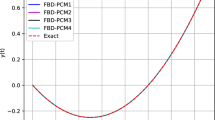Abstract
A global sensitivity analysis of complex computer codes is usually performed by calculating the Sobol indices. The indices are estimated using Monte Carlo methods. The Monte Carlo simulations are time-consuming even if the computer response is replaced by a metamodel. This paper proposes a new method for calculating sensitivity indices that overcomes the Monte Carlo estimation. The method assumes a discretization of the domain of simulation and uses the expansion of the computer response on an orthogonal basis of complex functions to built a metamodel. This metamodel is then used to derive an analytical estimation of the Sobol indices. This approach is successfully tested on analytical functions and is compared with two alternative methods.
Similar content being viewed by others
References
Bailey, R.A.: Factorial designs and abelian groups. Linear Algebra Appl. 70, 349–363 (1985)
Bates, R.A., Buck, R.J., Riccomagno, E., Wynn, H.P.: Experimental design and observation for large systems. J. R. Stat. Soc. B 58, 77–94 (1996)
Bates, R.A., Riccomagno, E., Schwabe, R., Wynn, H.P.: Lattices and dual lattices in optimal experimental design for Fourier models. Comput. Stat. Data Anal. 28, 283–296 (1998)
Fang, K.T., Li, R., Sudjianto, A.: Design and Modeling for Computer Experiments. Chapman & Hall, London (2006)
Husslage, B., Rennen, G., van Dam, E., den Hertog, D.: Space-filling Latin hypercube designs for computer experiments. CentER Discussion Paper 2008-104. Tilburg University (2008)
Johnson, M.E., Moore, L.M., Ylvisaker, D.: Minimax and maximin distance design. J. Stat. Plan. Inference 26, 131–148 (1990)
Kobilinsky, A.: Complex linear models and cyclic designs. Linear Algebra Appl. 127, 227–282 (1990)
Niederreiter, H.: Random number generation and quasi-Monte Carlo methods. Technical Report no4. CBMS-NSF, SIAM, Philadelphia, Illinois, Dept. of Statistics (1992)
Riccomagno, E., Schwabe, R., Wynn, H.P.: Lattice-based D-optimum design for Fourier regression. Ann. Stat. 25, 2313–2327 (1997)
Sacks, J., Welch, W.J., Mitchell, T.J., Wynn, H.P.: Design and analysis of computer experiments. Stat. Sci. 4, 409–435 (1989)
Saltelli, A., Tarantola, S., Chan, K.: A quantitative, model independent method for global sensitivity analysis of model output. Technometrics 41, 39–56 (1999)
Saltelli, A., Chan, K., Scott, M. (eds.): Sensitivity Analysis. Wiley Series in Probability and Statistics. Wiley, New York (2000)
Santner, T.J., Williams, B.J., Notz, W.I.: The Design and Analysis of Computer Experiments. Springer Series in Statistics. Springer, New York (2003)
Sobol, I.M.: Global sensitivity indices for nonlinear mathematical models and their Monte Carlo estimates. Math. Comput. Simul. 55, 271–280 (2001)
Sudret, B.: Global sensitivity analysis using polynomial chaos expansions. Reliab. Eng. Syst. Saf. 93, 964–979 (2008)
Author information
Authors and Affiliations
Corresponding author
Rights and permissions
About this article
Cite this article
Jourdan, A. Global sensitivity analysis using complex linear models. Stat Comput 22, 823–831 (2012). https://doi.org/10.1007/s11222-011-9239-y
Received:
Accepted:
Published:
Issue Date:
DOI: https://doi.org/10.1007/s11222-011-9239-y




